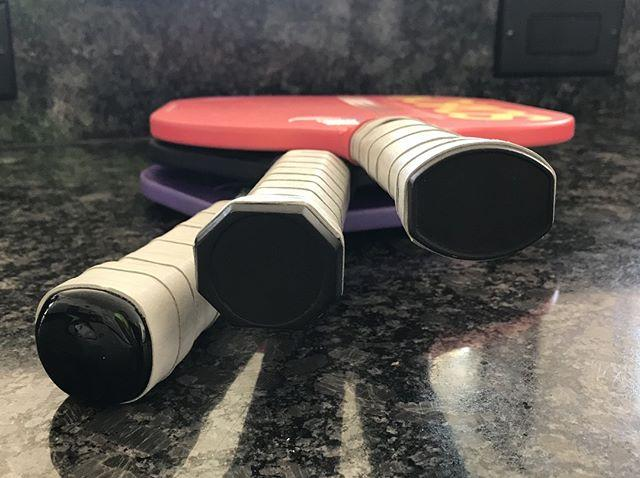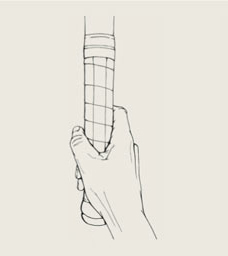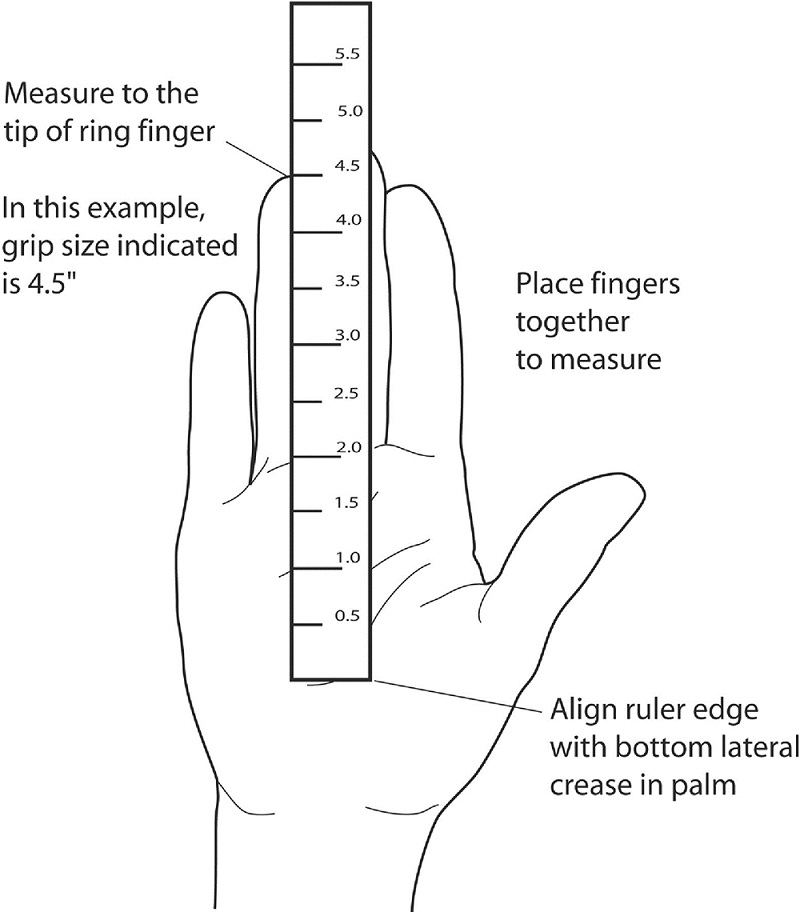
Before you choose a pickleball paddle grip size, you should take into consideration some factors such as handle shape, type of grip, and whether or not you will be using an overgrip. Typically, an overgrip will add either half or one whole size (1/16 to 1/8 inch) to the racquet. That’s obviously something you’ll want to keep in mind when looking for a racquet, and if you do choose to use an overgrip, you’ll want to find a paddle that is half to one size lower depending on what kind of overgrip you’ll be using.
There are basically two ways to measure your paddle grip grip size: either through the index finger test or the ruler test, although you will need to have a paddle on hand for the index finger test.
With a pickleball paddle, hold it with your dominant hand using an Eastern grip. If you don’t know what an Eastern grip is, it’s where the index knuckle and heel pad rests on the 3rd bevel. So your palm will be placed on the same bevel as the string face.
Once the Eastern grip has been achieved, use the index finger of your other hand to slide it in-between your ring finger and palm. The best paddle grip size for you will be the one where your index finger fits snugly within this gap. Not enough room or too much room means you have a grip that is either too small or too large.

Once you’ve found a snug fit, try the finger test a couple more times just to make sure. This is known as the scientific approach, which requires more than one test to confirm accurate results. Once you’ve found a paddle with a good fit, take a moment to take a deep breath. Smell that? That’s the smell of victory.

The second way of measuring tennis racquet grip size is with the ruler test. All you’ll need to accomplish this is a ruler and your dominant playing hand. First off, open your hand while having your fingers fully extended and close together. Take your ruler and align it until it’s parallel with your third finger (ring finger) with one end of the ruler in line with the bottom of the palm’s second (or middle) crease.
Your paddle grip size is then determined by the length between the tip of your ring finger and the bottom lateral palm crease. The length should fall somewhere between 4 inches and 5 inches.
Pickleball paddle grip sizes are often measured at the very middle of the paddle handle and range from 4 inches to 5 inches. This measurement is the circumference, or the distance around the edge of the handle, including any grip that may be applied to the racquet.
Depending on which country you live in you may find the sizing of the racquet grip expressed a bit differently, so we’ve provided a handy chart below that covers the different types of grip sizes.
|
US Sizes |
European Sizes |
Sizes in mm |
|
4 inches |
0 |
100-103 mm |
|
4 1/8 inches |
1 |
103-106 mm |
|
4 1/4 inches |
2 |
106-110 mm |
|
4 3/8 inches |
3 |
110-113 mm |
|
4 1/2 inches |
4 |
113-118 mm |
|
4 5/8 inches |
5 |
118-120 mm |
|
4 3/4 inches |
6 |
120-123 mm |
Beyond simply providing you with comfort when playing pickleball, the appropriate grip size can help prevent injury from prolonged use of a grip that is too small or too large.
The problem with a grip size that is too small is that your hand, wrist and arm will have to expend extra energy squeezing the handle to keep the racquet firmly in place. Over time this can contribute to injuries such as tennis elbow. You’ll also likely find that a grip which is too small will frequently slip from your hand which can be frustrating.
Similarly, a grip that’s too large can be challenging to hold and as a result put unnecessary stress on your hand, wrist and arm. In addition, a large grip can be difficult to manage when you need to change grips quickly or when you’re looking to snap your wrist when serving or hitting an overhead because it restricts movement.
The key is to find a grip size that feels comfortable, prevents undue stress on your body and allows for proper range of motion.
There are two common methods used to help identify the ideal grip size for a player. However, instead of using one, I typically recommend using both to help get the best fit.
First, if you have one handy, grab a ruler or measuring tape. Next, take a look at one of your hands and you’ll notice you have a bunch of lines and creases running through your palm. In the middle of your palm you’ll notice two large or pronounced lines, one on top and one on the bottom, running horizontally from one side of your hand to the other.
Grab your ruler or measuring tape and line it up vertically with your middle finger so that the bottom of the ruler (the part hitting your palm) lines up with the bottom horizontal line in your palm. Once you have it lined up measure to the top of your ring finger.
You should find that the measurement falls somewhere between 4 inches and 5 inches.
Start with the paddle grip size that is closest to what you measured and grab hold of the paddle handle with a continental grip.
At this point you should be able to stick your index finger of the hand not holding the racquet in between the tip of your middle finger and your palm. If it fits then you’re likely right on the mark.
However, keep in mind that it’s not an exact science so grab hold of the racquet grip size that’s bigger and then the one that’s smaller to get a feel for whether or not the grip you’ve identified feels right. For many players you’ll just know by holding on to each paddle. It should feel comfortable, yet secure.
Some players may feel like they are in between sizes. If that’s you, go for the smaller size. There are a bunch of different ways you can build up a grip to make it feel perfect, including the simple addition of an inexpensive overgrip. However, it is more difficult and in some cases not possible to drop the size of a grip.
Many players also like to use a new overgrip every few times they play to keep that nice tacky feel in their hand. If that’s you and you’re on the fence about a larger size definitely go smaller. Overgrips will usually add about 1/16 of an inch to a grip so if you go a bit smaller you freely add that overgrip without it starting to feel too bulky.